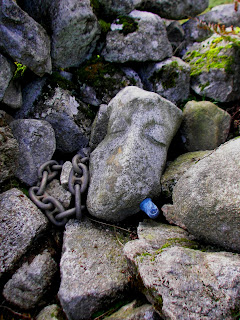Whilst I was up at Cairnsmore last week meeting Susumu Shingu I took the opportunity to see how some of my other works in this landscape were developing. Two of my Cairnsmore pieces, in particular, were conceived as 'time-based' works:
Scene Shifter is sited within sight of the iconic Big Water of Fleet railway viaduct. Abandoned since the mid 1960's the viaduct is slowly crumbling back into the landscape - this structure appears to most people to have been there for a 'long time' and will remain there 'forever'....and yet, when considering the forces that have actually dominated this land (and continue to do so) for millions of years - the lifespan of the viaduct will be only a couple of heartbeats.
Scene Shifter is made in bronze and takes a shape similar to a model or 'souvenir' of the viaduct, this is fixed to a boulder with a bronze chain. The boulder is in a burn and regularly submerged when the water level rises after heavy rain.
Scene Shifter just after installation - viaduct in background
detail showing intial colour of bronze
The concept behind Scene Shifter was that the bronze cast would be rubbed against the boulder by the water and would be worn away - like an electrode being depleted in a battery...its erosion being in dialogue with the decay of the viaduct
I began to receive images of the work under water - this from Andrew Bielinski:
...and this from Zvonko Kracun:
The raised area to the left of this photo is the top of the boulder
The following two photos were taken by me last week:
While it was difficult to see how much wearing down of the bronze had taken place, what was very clear was that the very slight acid pH of the water was continually 'cleaning' the bronze. So much so that the metal had that 'raw' and 'vulnerable' look that I have seen in metal that has just cooled in the foundry just as the first oxygen begins to react with the surface to begin the patination process. It seems that this constant renewal cycle is happening with Scene Shifter and not just abrasion is at work but a very gradual eating away with the natural acidity of the environment.
Heart is sited within the very scant remains of one of the only past habitations in this landscape - by and large this area is not one that has been a place for humans, it has always been shaped by the forces of pressure, ice, fire, wind and water rather than the actions of people. Heart reflects the light touch of humans on the landscape with two delicately carved partial faces that are place amongst the ruins and joined together by a bronze chain beneath the stone dyke. My intention was that the faces would become more and more faint as the stones were covered in algae and lichen.
One of the carved faces just after installation May 2008
Detail showing the 2 faces (2008)
This is Heart photographed last week (2 years and 6 months after first installation):










No comments:
Post a Comment